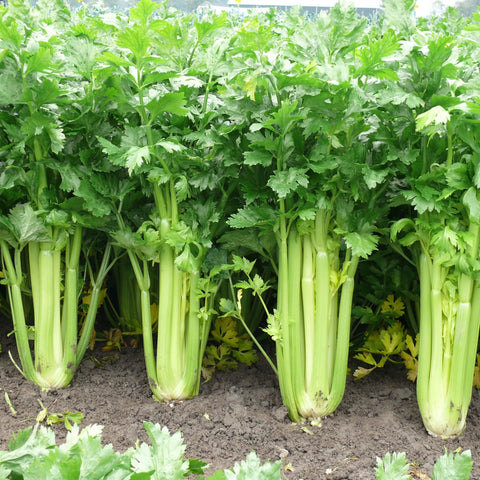

Hortinova
WINTER KING - Open Pollinated Celery Seeds
Apium graveolens var. dulce
- French heirloom variety also known as “Giant Pascal”.
- Medium-late variety (130-140 days from germination to harvest)
- Sought after for its cold resistance and excellent blanching capabilities.
- Vigorous and upright rosette with large leaves and thick fleshy stalks.
- Grows 2 feet high and has 2-inch-thick stems with a nutty flavor.
- The stalks are light green with a slightly ribbed surface.
To speed up germination, soak seeds in warm water overnight before sowing. Fill seed trays or pots with good-quality seed starting mix, then gently firm it level. Press soaked seeds into seed-starting soil; to get good germination, do not cover with soil. Carefully tap the packet above the surface of the potting mix and carefully drop the seeds on the surface. Ideally, you want them to fall about an inch apart. Firm the seeds into place. Cover starter trays/pots with plastic wrap to retain moisture. Germination should occur in about a week, but it can take up to three weeks. Soon after seedlings appear, place a fluorescent grow light 3 inches above them for 16 hours a day. Maintain an ambient temperature of 21° to 24°C during the day and 15° to 18°C at night. Mist regularly.
POTTING ON: When seedlings are 10-12cm (4-5″) tall, transplant them to individual peat pots or to deeper trays with new potting soil. Set the plants at least 2 inches apart. Harden off seedlings before transplanting by reducing water slightly and putting them outdoors (in a sheltered spot protected from the sun) for a couple of hours each day.
PLANT OUT: Plant celery outdoors when the soil temperature reaches at least 50°F (10°C) and nighttime temperatures don’t dip down below 40°F (4°C). (Cold weather after planting can cause bolting.) Plant seedlings 8 to 10 inches apart.
TEMPERATURE: Celery won’t tolerate high temperatures. It grows best in cool weather and needs a long period of mild temperatures ranging between 60°F and 70°F (15-21°C).
WATER: Water thoroughly and frequently. Make sure to provide plenty of water during the entire growing season, especially during hot, dry weather. Stalks will be small, stringy, tough, and/or hollow if it goes without water. Celery should not be planted in a well-draining soil. In fact, celery can tolerate poor drainage, and even likes wet soil.
FEED: Celery needs fertile soil to grow well. Start by amending any potting soil with compost or a balanced fertilizer. Add lots of compost and organic matter as your celery grows to maintain rich soil. Fertilize celery every 10-14 days with a balanced fertilizer, like a 5-10-10. Add compost and organic matter again every two weeks to maintain rich soil.
PROTECT: Use row covers for the first 4 to 5 weeks in order to protect from pests. When plants are 6 inches tall, mulch around them to keep the soil moist and roots cool. Keep celery weed-free, but be careful when weeding, as celery has shallow roots that could easily get disturbed.
BLANCHING: As the celery stalks become darker in color, they are more nutrient-dense, but also tougher and stringier. For mild and sweeter tasting celery, harvest stalks before they darken, or cover them to prevent the plant from getting darker in the sunlight.
For best flavor and longer storage, water plants the day before harvest. You can harvest plants whole, but cutting or picking individual stems as required will keep plants producing over a longer period. Cut stalks as needed from the outside of the plant using a sharp knife. You can also wait to harvest the whole plant by cutting at soil level when all stems have reached full size, about 2 to 2.5′ tall. Harvest stalks from the outside in.
Let customers speak for us
from 23 reviewsWe grow several varieties of various colours of tomatoes, and the contrast of these tomatoes with other colours is fantastic. We've had a very long season with our plants, excellent disease resistance, great flavour.

This review applies to all of the seeds I purchased from Hortinova - beautiful tomatoes, good disease resistance and excellent production. Our field season extended to 10 weeks. We've had comments of excellent flavour from our customers as well, highly recommend any Hortinova seed.

This tomato is good taste tomato. Small red round tomato. Bigger then cherry tomatoes but smaller then regular one. I like it. Perfect for salads and fresh eating. Ordered seeds for next season.

2nd time ordering. Very satisfied with qualify and result. Thank you

BALCONY YELLOW F1 - Hybrid Cherry Tomato Seeds

Delivered very fast, packed very good, in professional condition and quality. Thanks

DUETT - Open Pollinated Radish Seeds

We will see what they are like this summer.

Type crimson de bonne grosseur avec une superbe uniformité et très hâtif. Un des premiers prêt en saison. Semences très petites et peu nombreuses. Goût très sucré et chaire croquante. Chair passant du rose au rouge en cours de saison. Les plants sont forts et très vigoureux avec des grosses feuilles.

Vigueur des plants impressionante avec des fruits résistants aux fissures et aux dommages. Très bonne conservartion et goût très sucré lorsque les nervures deviennent orange. Peu être récolté lorsque les nervures sont vertes également. Cavité des semences très compacte et petite laissant beaucoup de chair.

Melon qui fond en boûche avec un goût se rapprochant du melon miel et du cantaloup à la fois, très sucré. Faire attention aux irriguations lorsque le melon devient mature car il peut fendre au champs. Très odorant.

Avec son apparence côtellée, son très gros calibre et ça couleur rose, cette tomate se démarque des autres sur les tablettes. Variété plus résistante à la pourriture apicale que la plus part des autres tomates roses. Bon ensemble de résitance aux maladies également.

Tomate noire dont les faces qui ne sont pas exposé au soleil passent du vert au rouge lorsque mature donnant un aspect unique aux fruits. Charactéristiques similaires à la Barrio avec un goût superbe sans acide. Les clients l'on adoré.

Superbe adaptabilité et excellente résistance aux maladies. Fruits uniformes qui ne fendent pas, bonne conservation. Ajoutez à cela un goût unique avec une légère acidité et une pointe sucré.















